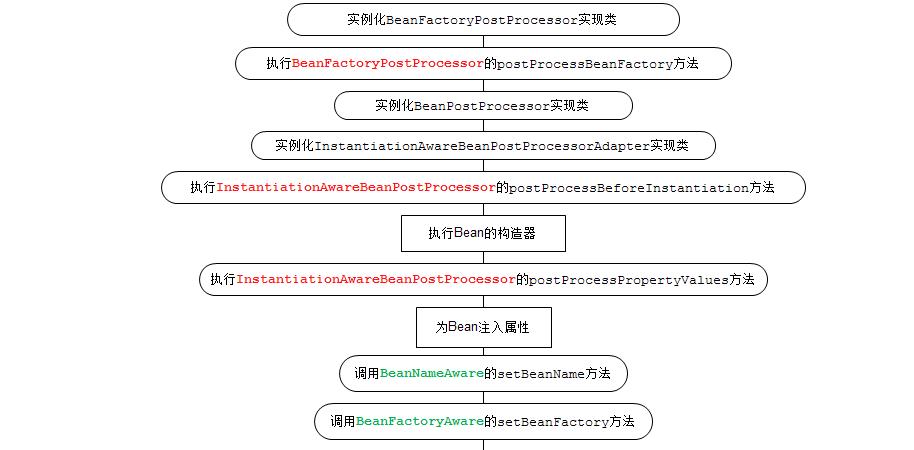转载请注明地址 http://www.cnblogs.com/zrtqsk/p/3735273.html,谢谢。
一、生命周期流程图:
Spring Bean的完整生命周期从创建Spring容器开始,直到最终Spring容器销毁Bean,这其中包含了一系列关键点。


若容器注册了以上各种接口,程序那么将会按照以上的流程进行。下面将仔细讲解各接口作用。
二、各种接口方法分类
Bean的完整生命周期经历了各种方法调用,这些方法可以划分为以下几类:
1、Bean自身的方法 : 这个包括了Bean本身调用的方法和通过配置文件中<bean>的init-method和destroy-method指定的方法
目标方法执行前后执行后,将进行初始化或销毁。
<bean id="" class="" init-method="初始化方法名称" destroy-method="销毁的方法名称">
2、Bean级生命周期接口方法 : 这个包括了BeanNameAware、BeanFactoryAware、InitializingBean和DiposableBean这些接口的方法
3、容器级生命周期接口方法 : 这个包括了InstantiationAwareBeanPostProcessor 和 BeanPostProcessor 这两个接口实现,一般称它们的实现类为“后处理器”。
4、工厂后处理器接口方法 : 这个包括了AspectJWeavingEnabler, ConfigurationClassPostProcessor, CustomAutowireConfigurer等等非常有用的工厂后处理器 接口的方法。工厂后处理器也是容器级的。在应用上下文装配配置文件之后立即调用。
三、演示
我们用一个简单的Spring Bean来演示一下Spring Bean的生命周期。
1、首先是一个简单的Spring Bean,调用Bean自身的方法和Bean级生命周期接口方法,为了方便演示,它实现了BeanNameAware、BeanFactoryAware、InitializingBean和DiposableBean这4个接口,同时有2个方法,对应配置文件中<bean>的init-method和destroy-method。如下:
package springBeanTest;
import org.springframework.beans.BeansException;
import org.springframework.beans.factory.BeanFactory;
import org.springframework.beans.factory.BeanFactoryAware;
import org.springframework.beans.factory.BeanNameAware;
import org.springframework.beans.factory.DisposableBean;
import org.springframework.beans.factory.InitializingBean;
/**
* @author qsk
*/
public class Person implements BeanFactoryAware, BeanNameAware,
InitializingBean, DisposableBean {
private String name;
private String address;
private int phone;
private BeanFactory beanFactory;
private String beanName;
public Person() {
System.out.println("【构造器】调用Person的构造器实例化");
}
public String getName() {
return name;
}
public void setName(String name) {
System.out.println("【注入属性】注入属性name");
this.name = name;
}
public String getAddress() {
return address;
}
public void setAddress(String address) {
System.out.println("【注入属性】注入属性address");
this.address = address;
}
public int getPhone() {
return phone;
}
public void setPhone(int phone) {
System.out.println("【注入属性】注入属性phone");
this.phone = phone;
}
@Override
public String toString() {
return "Person [address=" + address + ", name=" + name + ", phone="
+ phone + "]";
}
// 这是BeanFactoryAware接口方法
@Override
public void setBeanFactory(BeanFactory arg0) throws BeansException {
System.out.println("【BeanFactoryAware接口】调用BeanFactoryAware.setBeanFactory()");
this.beanFactory = arg0;
}
// 这是BeanNameAware接口方法
@Override
public void setBeanName(String arg0) {
System.out.println("【BeanNameAware接口】调用BeanNameAware.setBeanName()");
this.beanName = arg0;
}
// 这是InitializingBean接口方法
@Override
public void afterPropertiesSet() throws Exception {
System.out.println("【InitializingBean接口】调用InitializingBean.afterPropertiesSet()");
}
// 这是DiposibleBean接口方法
@Override
public void destroy() throws Exception {
System.out.println("【DiposibleBean接口】调用DiposibleBean.destory()");
}
// 通过<bean>的init-method属性指定的初始化方法
public void myInit() {
System.out.println("【init-method】调用<bean>的init-method属性指定的初始化方法");
}
// 通过<bean>的destroy-method属性指定的初始化方法
public void myDestory() {
System.out.println("【destroy-method】调用<bean>的destroy-method属性指定的初始化方法");
}
}
2、接下来是演示BeanPostProcessor接口的方法,如下:
package springBeanTest;
import org.springframework.beans.BeansException;
import org.springframework.beans.factory.config.BeanPostProcessor;
public class MyBeanPostProcessor implements BeanPostProcessor {
public MyBeanPostProcessor() {
super();
System.out.println("这是BeanPostProcessor实现类构造器!!");
// TODO Auto-generated constructor stub
}
@Override
public Object postProcessAfterInitialization(Object arg0, String arg1)
throws BeansException {
System.out.println("BeanPostProcessor接口方法postProcessAfterInitialization对属性进行更改!");
return arg0;
}
@Override
public Object postProcessBeforeInitialization(Object arg0, String arg1)
throws BeansException {
System.out
.println("BeanPostProcessor接口方法postProcessBeforeInitialization对属性进行更改!");
return arg0;
}
}
如上,BeanPostProcessor接口包括2个方法postProcessAfterInitialization和postProcessBeforeInitialization,这两个方法的第一个参数都是要处理的Bean对象,第二个参数都是Bean的name。返回值也都是要处理的Bean对象。这里要注意。
3、InstantiationAwareBeanPostProcessor 接口本质是BeanPostProcessor的子接口,一般我们继承Spring为其提供的适配器类InstantiationAwareBeanPostProcessor Adapter来使用它,如下:
package springBeanTest;
import java.beans.PropertyDescriptor;
import org.springframework.beans.BeansException;
import org.springframework.beans.PropertyValues;
import org.springframework.beans.factory.config.InstantiationAwareBeanPostProcessorAdapter;
public class MyInstantiationAwareBeanPostProcessor extends
InstantiationAwareBeanPostProcessorAdapter {
public MyInstantiationAwareBeanPostProcessor() {
super();
System.out.println("这是InstantiationAwareBeanPostProcessorAdapter实现类构造器!!");
}
// 接口方法、实例化Bean之前调用
@Override
public Object postProcessBeforeInstantiation(Class beanClass,
String beanName) throws BeansException {
System.out.println("InstantiationAwareBeanPostProcessor调用postProcessBeforeInstantiation方法");
return null;
}
// 接口方法、实例化Bean之后调用
@Override
public Object postProcessAfterInitialization(Object bean, String beanName)
throws BeansException {
System.out
.println("InstantiationAwareBeanPostProcessor调用postProcessAfterInitialization方法");
return bean;
}
// 接口方法、设置某个属性时调用
@Override
public PropertyValues postProcessPropertyValues(PropertyValues pvs,
PropertyDescriptor[] pds, Object bean, String beanName)
throws BeansException {
System.out
.println("InstantiationAwareBeanPostProcessor调用postProcessPropertyValues方法");
return pvs;
}
}
这个有3个方法,其中第二个方法postProcessAfterInitialization就是重写了BeanPostProcessor的方法。第三个方法postProcessPropertyValues用来操作属性,返回值也应该是PropertyValues对象。
4、演示工厂后处理器接口方法,如下:
package springBeanTest;
import org.springframework.beans.BeansException;
import org.springframework.beans.factory.config.BeanDefinition;
import org.springframework.beans.factory.config.BeanFactoryPostProcessor;
import org.springframework.beans.factory.config.ConfigurableListableBeanFactory;
public class MyBeanFactoryPostProcessor implements BeanFactoryPostProcessor {
public MyBeanFactoryPostProcessor() {
super();
System.out.println("这是BeanFactoryPostProcessor实现类构造器!!");
}
@Override
public void postProcessBeanFactory(ConfigurableListableBeanFactory arg0)
throws BeansException {
System.out
.println("BeanFactoryPostProcessor调用postProcessBeanFactory方法");
BeanDefinition bd = arg0.getBeanDefinition("person");
bd.getPropertyValues().addPropertyValue("phone", "110");
}
}
5、配置文件如下beans.xml,很简单,使用ApplicationContext,处理器不用手动注册:
<?xml version="1.0" encoding="UTF-8"?>
<beans xmlns="http://www.springframework.org/schema/beans"
xmlns:xsi="http://www.w3.org/2001/XMLSchema-instance" xmlns:p="http://www.springframework.org/schema/p"
xmlns:aop="http://www.springframework.org/schema/aop" xmlns:tx="http://www.springframework.org/schema/tx"
xsi:schemaLocation="
http://www.springframework.org/schema/beans
http://www.springframework.org/schema/beans/spring-beans-3.2.xsd">
<bean id="beanPostProcessor" class="springBeanTest.MyBeanPostProcessor">
</bean>
<bean id="instantiationAwareBeanPostProcessor" class="springBeanTest.MyInstantiationAwareBeanPostProcessor">
</bean>
<bean id="beanFactoryPostProcessor" class="springBeanTest.MyBeanFactoryPostProcessor">
</bean>
<bean id="person" class="springBeanTest.Person" init-method="myInit"
destroy-method="myDestory" scope="singleton" p:name="张三" p:address="广州"
p:phone="15900000000" />
</beans>
6、下面测试一下:
package springBeanTest;
import org.springframework.context.ApplicationContext;
import org.springframework.context.support.ClassPathXmlApplicationContext;
public class BeanLifeCycle {
public static void main(String[] args) {
System.out.println("现在开始初始化容器");
ApplicationContext factory = new ClassPathXmlApplicationContext("springBeanTest/beans.xml");
System.out.println("容器初始化成功");
//得到Preson,并使用
Person person = factory.getBean("person",Person.class);
System.out.println(person);
System.out.println("现在开始关闭容器!");
((ClassPathXmlApplicationContext)factory).registerShutdownHook();
}
}
关闭容器使用的是实际是AbstractApplicationContext的钩子方法。
我们来看一下结果:
现在开始初始化容器 2014-5-18 15:46:20 org.springframework.context.support.AbstractApplicationContext prepareRefresh 信息: Refreshing org.springframework.context.support.ClassPathXmlApplicationContext@19a0c7c: startup date [Sun May 18 15:46:20 CST 2014]; root of context hierarchy 2014-5-18 15:46:20 org.springframework.beans.factory.xml.XmlBeanDefinitionReader loadBeanDefinitions 信息: Loading XML bean definitions from class path resource [springBeanTest/beans.xml] 这是BeanFactoryPostProcessor实现类构造器!! BeanFactoryPostProcessor调用postProcessBeanFactory方法 这是BeanPostProcessor实现类构造器!! 这是InstantiationAwareBeanPostProcessorAdapter实现类构造器!! 2014-5-18 15:46:20 org.springframework.beans.factory.support.DefaultListableBeanFactory preInstantiateSingletons 信息: Pre-instantiating singletons in org.springframework.beans.factory.support.DefaultListableBeanFactory@9934d4: defining beans [beanPostProcessor,instantiationAwareBeanPostProcessor,beanFactoryPostProcessor,person]; root of factory hierarchy InstantiationAwareBeanPostProcessor调用postProcessBeforeInstantiation方法 【构造器】调用Person的构造器实例化 InstantiationAwareBeanPostProcessor调用postProcessPropertyValues方法 【注入属性】注入属性address 【注入属性】注入属性name 【注入属性】注入属性phone 【BeanNameAware接口】调用BeanNameAware.setBeanName() 【BeanFactoryAware接口】调用BeanFactoryAware.setBeanFactory() BeanPostProcessor接口方法postProcessBeforeInitialization对属性进行更改! 【InitializingBean接口】调用InitializingBean.afterPropertiesSet() 【init-method】调用<bean>的init-method属性指定的初始化方法 BeanPostProcessor接口方法postProcessAfterInitialization对属性进行更改! InstantiationAwareBeanPostProcessor调用postProcessAfterInitialization方法 容器初始化成功 Person [address=广州, name=张三, phone=110] 现在开始关闭容器! 【DiposibleBean接口】调用DiposibleBean.destory() 【destroy-method】调用<bean>的destroy-method属性指定的初始化方法
